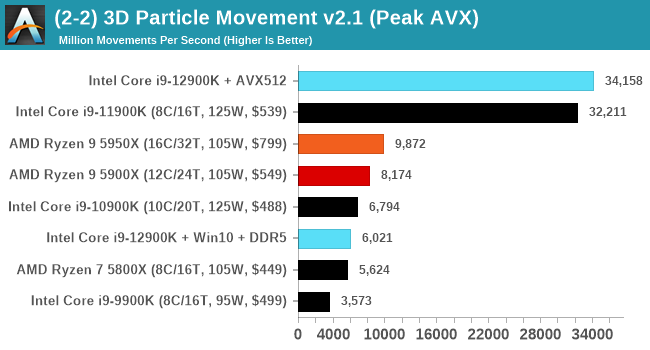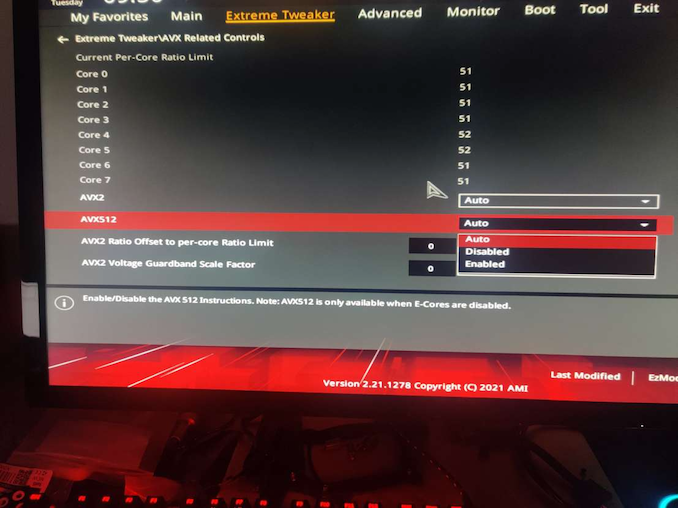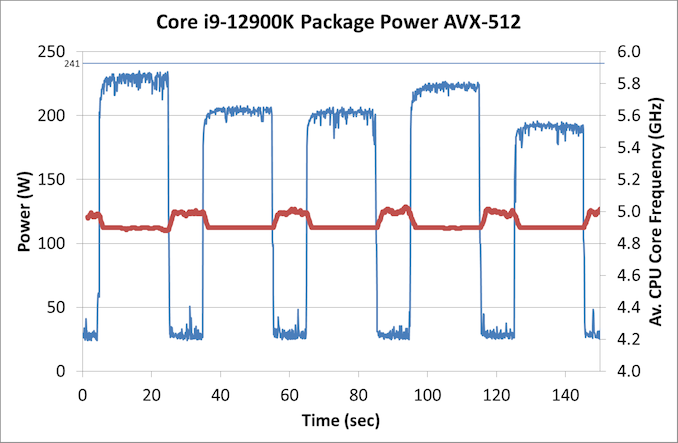The Intel 12th Gen Core i9-12900K Review: Hybrid Performance Brings Hybrid Complexity
by Dr. Ian Cutress & Andrei Frumusanu on November 4, 2021 9:00 AM ESTIntel Disabled AVX-512, but Not Really
One of the more interesting disclosures about Alder Lake earlier this year is that the processor would not have Intel’s latest 512-bit vector extensions, AVX-512, despite the company making a big song and dance about how it was working with software developers to optimize for it, why it was in their laptop chips, and how no transistor should be left behind. One of the issues was that the processor, inside the silicon, actually did have the AVX-512 unit there. We were told as part of the extra Architecture Day Q&A that it would be fused off, and the plan was for all Alder Lake CPUs to have it fused off.
Part of the issue of AVX-512 support on Alder Lake was that only the P-cores have the feature in the design, and the E-cores do not. One of the downsides of most operating system design is that when a new program starts, there’s no way to accurately determine which core it will be placed on, or if the code will take a path that includes AVX-512. So if, naively, AVX-512 code was run on a processor that did not understand it, like an E-core, it would cause a critical error, which could cause the system to crash. Experts in the area have pointed out that technically the chip could be designed to catch the error and hand off the thread to the right core, but Intel hasn’t done this here as it adds complexity. By disabling AVX-512 in Alder Lake, it means that both the P-cores and the E-cores have a unified common instruction set, and they can both run all software supported on either.
There was a thought that if Intel were to release a version of Alder Lake with P-cores only, or if a system had all the E-cores disabled, there might be an option to have AVX-512. Intel shot down that concept almost immediately, saying very succinctly that no Alder Lake CPU would support AVX-512.
Nonetheless, we test to see if it is actually fused off.
On my first system, the MSI motherboard, I could easily disable the E-cores. That was no problem, just adjust the BIOS to zero E-cores. However this wasn’t sufficient, as AVX-512 was still clearly not detected.
On a second system, an ASUS motherboard, there was some funny option in the BIOS.
Well I’ll be a monkey’s uncle. There’s an option, right there, front and centre for AVX-512. So we disable the E-cores and enable this option. We have AVX-512 support.
For those that have some insight into AVX-512 might be aware that there are a couple of dozen different versions/add-ons of AVX-512. We confirmed that the P-cores in Alder Lake have:
- AVX512-F / F_X64
- AVX512-DQ / DQ_X64
- AVX512-CD
- AVX512-BW / BW_X64
- AVX512-VL / VLBW / VLDQ / VL_IFMA / VL_VBMI / VL_VNNI
- AVX512_VNNI
- AVX512_VBMI / VBMI2
- AVX512_IFMA
- AVX512_BITALG
- AVX512_VAES
- AVX512_VPCLMULQDQ
- AVX512_GFNI
- AVX512_BF16
- AVX512_VP2INTERSECT
- AVX512_FP16
This is, essentially, the full Sapphire Rapids AVX-512 support. That makes sense, given that this is the same core that’s meant to be in Sapphire Rapids (albeit with cache changes). The core also supports dual AVX-512 ports, as we’re detecting a throughput of 2 per cycle on 512-bit add/subtracts.
For performance, I’m using our trusty 3DPMAVX benchmark here, and compared to the previous generation Rocket Lake (which did have AVX-512), the score increases by a few percent in a scenario which isn’t DRAM limited.

Now back in that Rocket Lake review, we noted that the highest power consumption observed for the chip was during AVX-512 operation. At that time, our testing showcased a big +50W jump between AVX2 and AVX-512 workloads. This time around however, Intel has managed to adjust the power requirements for AVX-512, and in our testing they were very reasonable:
In this graph, we’re showing each of the 3DPM algorithms running for 20 seconds, then idling for 10 seconds. Each one has a different intensity of AVX-512, hence why the power is up and down. IN each instance, the CPU used an all-core turbo frequency of 4.9 GHz, in line with non-AVX code, and our peak power observed is actually 233 W, well below the 241 W rated for processor turbo.
Why?
So the question then refocuses back on Intel. Why was AVX-512 support for Alder Lake dropped, and why were we told that it is fused off, when clearly it isn’t?
Based on a variety of conversations with individuals I won’t name, it appears that the plan to have AVX-512 in Alder Lake was there from the beginning. It was working on early silicon, even as far as ES1/ES2 silicon, and was enabled in the firmware. Then for whatever reason, someone decided to remove that support from Intel’s Plan of Record (POR, the features list of the product).
By removing it from the POR, this means that the feature did not have to be validated for retail, which partly speeds up the binning and testing/validation process. As far as I understand it, the engineers working on the feature were livid. While all their hard work would be put to use on Sapphire Rapids, it still meant that Alder Lake would drop the feature and those that wanted to prepare for Alder Lake would have to remain on simulated support. Not only that, as we’ve seen since Architecture Day, it’s been a bit of a marketing headache. Whoever initiated that dropped support clearly didn’t think of how that messaging was going to down, or how they were going to spin it into a positive. For the record, removing support isn’t a positive, especially given how much hullaballoo it seems to have caused.
We’ve done some extensive research on what Intel has done in order to ‘disable’ AVX-512. It looks like that in the base firmware that Intel creates, there is an option to enable/disable the unit, as there probably is for a lot of other features. Intel then hands this base firmware to the vendors and they adjust it how they wish. As far as we understand, when the decision to drop AVX-512 from the POR was made, the option to enable/disable AVX-512 was obfuscated in the base firmware. The idea is that the motherboard vendors wouldn’t be able to change the option unless they specifically knew how to – the standard hook to change that option was gone.
However, some motherboard vendors have figured it out. In our discoveries, we have learned that this works on ASUS, GIGABYTE, and ASRock motherboards, however MSI motherboards do not have this option. It’s worth noting that all the motherboard vendors likely designed all of their boards on the premise that AVX-512 and its high current draw needs would be there, so when Intel cut it, it meant perhaps that some boards were over-engineered with a higher cost than needed. I bet a few weren’t happy.
Update: MSI reached out to me and have said they will have this feature in BIOS versions 1.11 and above. Some boards already have the BIOS available, the rest will follow shortly.
But AVX-512 is enabled, and we are now in a state of limbo on this. Clearly the unit isn’t fused off, it’s just been hidden. Some engineers are annoyed, but other smart engineers at the motherboard vendors figured it out. So what does Intel do from here?
First, Intel could put the hammer down and execute a scorched earth policy. Completely strip out the firmware for AVX-512, and dictate that future BIOS/UEFI releases on all motherboards going forward cannot have this option, lest the motherboard manufacturer face some sort of wrath / decrease in marketing discretionary funds / support. Any future CPUs coming out of the factory would actually have the unit fused out, rather than simply turned off.
Second, Intel could lift the lid, acknowledge that someone made an error, and state that they’re prepared to properly support it in future consumer chips with proper validation when in a P-core only mode. This includes the upcoming P-core only chips next year.
Third, treat it like overclocking. It is what it is, your mileage may vary, no guarantee of performance consistency, and any errata generated will not be fixed in future revisions.
As I’ve mentioned, apparently this decision didn’t go down to well. I’m still trying to find the name of the person/people who made this decision, and get their side of the story as to technically why this decision was made. We were told that ‘No Transistor Left Behind’, except these ones in that person’s mind, clearly.












474 Comments
View All Comments
mode_13h - Friday, November 5, 2021 - link
It basically comes down to a context-switch. And those take a couple microseconds (i.e. many thousands of CPU cycles), last I checked. And that assumes there's a P-core available to run the thread. If not, you're potentially going to have to wait a few timeslices (often 1 -10 ms).Now, consider the case of some software that assumes all cores are AVX-512 capable. This would be basically all AVX-512 software written to date, because we've never had a hybrid one, or even the suggestion from Intel that we might need to worry about such a thing. So, the software spawns 1 thread per hyperthread (i.e. 24 threads on the i9-12900K) but can only run 16 of them at any time. That's going to result in a performance slowdown, especially when you account for all the fault-handling and context-switching that happens whenever any of these threads tries to run on an E-core. You'd basically end up thrashing the E-cores, burning a lot of power and getting no real work done on them.
mode_13h - Friday, November 5, 2021 - link
Forgot to address the case where the OS blocks the thread from running on the E-core, again.So, if we think about how worker threads are used to split up bigger tasks, you really want to have no more worker threads than actual CPU resources that can execute them. You don't want a bunch of worker threads all fighting to run on a smaller number of cores.
So, even the solution of having the OS block those threads from running on the E-cores would yield lower performance than if the the app knew how many AVX-512 capable cores there were and spawned only that many worker threads. However, you have to keep in mind that whether some function uses AVX-512 is not apparent to a software developer. It might even do this dynamically, based on whether AVX-512 is detected, but this detection often happens at startup and then the hardware support is presumed to be invariant. So, it's problematic to dump the problem in the application developer's lap.
eastcoast_pete - Thursday, November 4, 2021 - link
Plus, enabling AVX-512 on the big Cores would have meant having it on the E (Gracemont) cores also, or switching workloads from P to E cores on the fly won't "fly". And having AVX-512 in Gracemont would have interfered with the whole idea of Gracemonts being low-power and small footprint on the die. I actually find what Ian and Andrei did here quite interesting: if AVX-512 can really speed up whatever you want to do, disable the Gracemonts and run AL in Cove only. If that could be a supported option with a quick restart, it might be worthwhile under the right circumstances.AntonErtl - Friday, November 5, 2021 - link
There is no relevant AVX-512 state before the first AVX-512 instruction is executed. So trapping and switching to a P-core is entirely doable. Switching back would probably be a bigger problem, but one probably does not want to do that anyway.Spunjji - Friday, November 5, 2021 - link
Possible problem: how would you account for a scenario where the gain from AVX-512 is smaller than the gain from running additional threads on E cores? Especially when some processors have a greater proportion of E cores to P cores than others. That could get quite complicated.TeXWiller - Friday, November 5, 2021 - link
If you look at the Intel's prerelease presentation about Thread Director carefully, you see they are indeed talking about moving the integer (likely control) sections of AVX threads to E-cores and back as needed.kobblestown - Friday, November 5, 2021 - link
I'll reply to my comment because it seems the original one was not understood.When you have an AVX512-using thread on a P thread, it might happen that it needs to be suspended, say, because the CPU is overloaded. Then the whole CPU state is saved to memory so the execution can later be resumed as if nothing has happened. In particular, it may be rescheduled on another core when its time for it run again. If that new core is a P core, then we're safe. But if it's an E core, it might happen that we hit an AVX512 instruction. Obviously, the core cannot execute it so it traps into the OS. The OS can check what was the offending instruction and determine that the problem is not the instruction, but the core. So it moves it back to a P core, stores a flag that this thread should not be rescheduled on an E-core and keeps chugging.
Now, someone suggested that there might be a problem with the CPU state. And, indeed, you can not restore the AVX512 part of the state on an E core. But it cannot get changed by an E core either, because at the first attempt to do it it will trap. So the AVX512 part of the state that was saved on a P core is still correct.
Since this isn't being done, there might be (but not "must be" - intel, like AMD, will only do what is good for them, not what is good for us) some problem. One being that an AVX512 thread will never be rescheduled on an E core even if it executes a single AVX512 instruction. But it's still better than the current situation which postpones the wider adoption of AVX512 yet again. I mean, the transistors are already there!
factual - Thursday, November 4, 2021 - link
Great win for consumers! AMD will need to cut prices dramatically to be competitive otherwise Intel will dominate until Zen4 comes out!kobblestown - Friday, November 5, 2021 - link
Let's first see Zen3D early next year. It will let me keep my investment into the AM4 platform yet offer top notch performance.Spunjji - Friday, November 5, 2021 - link
"AMD will need to cut prices dramatically"Not until Intel's platform costs drop. Nobody's buying an ADL CPU by itself.